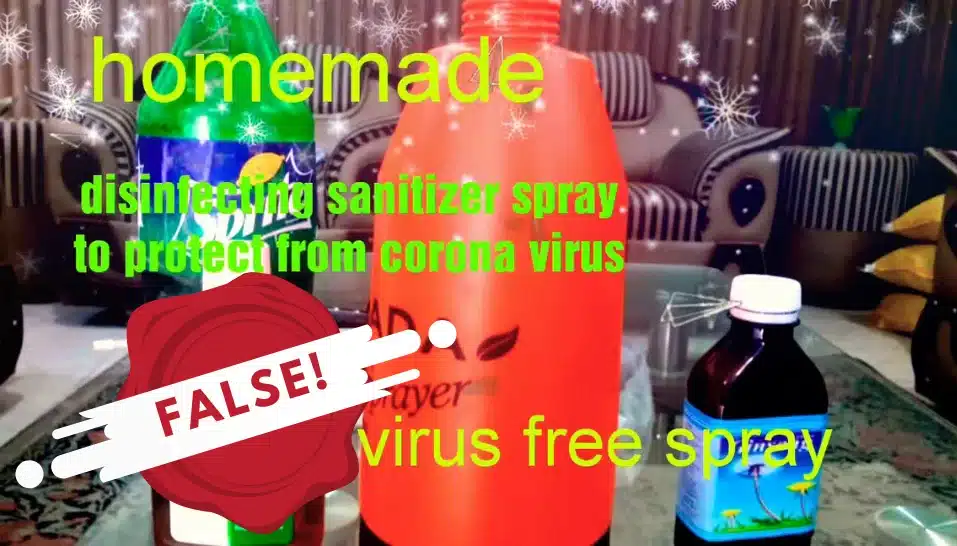Youtube is awash with how to disinfect surfaces and many people have resorted to trying to make their own disinfectants by watching viral do-it-yourself (DIY) videos and YouTube tutorials. But mixing chemicals in the wrong proportion can at best create an ineffective product – and at worst result in poisoning.
Videos about how to make disinfectants at home are again getting wide popularity. We at First Check found videos that promoted mixing cocktails of chemicals to make some multi-purpose homemade disinfectant sprays that are neither lab-tested nor created under the supervision of any cleaning experts.
While the World Health Organisation (WHO) suggests that sanitising homes and workplaces with disinfectants is a great way to kill germs and get rid of pathogens, however, if experts are to be believed, when it comes to environmental surface cleaning, a lot of us get it wrong.
Infact, since the pandemic began, microblogging sites such as YouTube and Facebook have seen growth in the sheer volume of such non-tested homemade, DIY (do it yourself) disinfectants. And what’s worrying is the fact that most of the content and DIY recipes published online are not even tested or approved.
The WHO’s report on ‘cleaning and disinfection of environmental surfaces in the context of COVID-19’ also highlights that, “disinfectant solutions must be prepared and used according to the manufacturer’s recommendations for volume and contact time as concentrations with inadequate dilution during preparation (too high or too low) may reduce their effectiveness.”
“High concentrations increase chemical exposure to users and may also damage surfaces,” reads the WHO report.
One such video tutoring people on how to make a disinfecting corona-free spray at home has already been viewed thousands of times on YouTube.
The video emphasising that the liquid should be sprayed regularly on daily objects and surfaces of the furniture, entrance door, kitchen counters, etc. is to be followed with utmost caution as WHO in its guidelines has clearly mentioned, “when it comes to indoor spaces, routine application of disinfectants to environmental surfaces by spraying or fogging is not recommended for COVID-19”.
“Moreover, spraying disinfectants can also cause eye irritation or infection, respiratory or skin problems and the resulting health effects.”
The video further goes on to explain how alcohol, Dettol and spirit can be mixed well to form a solution and sprayed all over the house.
Whereas WHO suggests that “wiping a surface with a cloth dipped in disinfectant is sufficient”.
Another video that caught our attention on the YouTube channel explained how to make bleach disinfectant wipes at home.
While the video, posted on March 20, has already got over two thousand likes, it’s in total contradiction with the WHO’s guidelines.
According to WHO spraying or introducing bleach or any other disinfectant into your body can prove harmful.
“Bleach can be poisonous if ingested and it causes irritation and damage to skin and eyes. Bleach-based disinfectants should be used carefully to disinfect surfaces only,” said the WHO report on COVID-19.
It’s important to know that bleach is caustic and can emit lethal fumes. It is therefore important to dilute bleach and ensure that it is not mixed with other solutions and chemicals.
What many people do not know is that you need to wipe the bleach off after the 10-minute dwell time. If it is left to sit indefinitely, bleach can damage hard objects and even metals like stainless steel.
Internet is awash with information on not just how to make disinfectants at home but also how to regularly sanitise and disinfect your surrounding with surface disinfectants available in markets.
Besides chemicals, there are claims that ironing clothes, masks, aprons and banknotes can help in killing the deadly virus.
It may sound bizarre but a few viral videos vouch for its effectiveness. While busting the prevalent myth, Dr. Rohini Karandhikar, Science educator and member of the Indian Scientists’ & Response to COVID-19 team said, “Just applying heat may not be enough as a piece of cloth must be exposed to 75 deg.C or for minimum 5-10 minutes. Disinfection of masks and clothes with soap and water is the best-proven way.”
While it’s recommended to keep your environment and personal space clean, what’s more important is to practice good hand hygiene, wear masks and maintain social distance.


















Add Comment